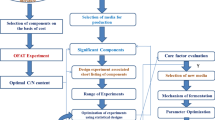Abstract
The production of inulinase employing agroindustrial residues as the substrate is a good alternative to reduce production costs and to minimize the environmental impact of disposing these residues in the environment. This study focused on the use of a phenomenological model and an artificial neural network (ANN) to simulate the inulinase production during the batch cultivation of the yeast Kluyveromyces marxianus NRRL Y-7571, employing a medium containing agroindustrial residues such as molasses, corn steep liquor and yeast extract. It was concluded that due to the complexity of the medium composition it was rather difficult to use a phenomenological model with sufficient accuracy. For this reason, an alternative and more cost-effective methodology based on ANN was adopted. The predictive capacity of the ANN was superior to that of the phenomenological model, indicating that the neural network approach could be used as an alternative in the predictive modeling of complex batch cultivations.


Similar content being viewed by others
References
Sangeetha PT, Ramesh MN, Prapulla SG (2005) Recent trends in the microbial production, analysis and application of fructooligosacharides. Trends Food Sci Technol 16:442–457
Kalil SJ, Suzan R, Maugeri F, Rodrigues MI (2001) Optimization of inulinase production by Kluyveromyces marxianus using factorial design. Appl Biochem Biotechnol 94:257–264
Silva-Santisteban BOY, Maugeri F (2005) Agitation, aeration and shear stress as key factors in inulinase production by Kluyveromyces marxianus. Enzyme Microb Technol 36:717–724
Treichel H (2004) Studies of the otimização of the production of inulinase for Kluyveromyces marxianus NRRL Y-7571 in half daily pay-treat industrials. PhD Thesis, Campinas State University-UNICAMP
Sguarezi C, Longo C, Ceni G, Boni G, Mazutti MA, Treichel H (2007) Inulinase production by agroindustrial residues: acid pre-treatment of substrates and optimization of production. Food Bioprocess Technol. doi:10.1007/s11947-007-0042-x
Mazutti MA, Bender JP, Di Luccio M, Treichel H (2006) Optimization of inulinase production by solid state fermentation using sugar cane bagasse. Enzyme Microb Technol 39:56–59
Bender JP, Mazutti MA, Treichel H, Di Luccio M (2006) Inulinase production by Kluyveromyces marxianus NRRL Y–7571 using solid state fermentation. Appl Biochem Biotechnol 32:951–958
van Can HJL, te Braake HAB, Bijman A, Helling C, Luyben KCh, Heijnen JJ (1999) An efficient model development strategy for bioprocess based on neural networks in macroscopic balances: part II. Biotechnol Bioeng 62:666–670
Zorzeto LFM, Maciel Filho R, Wolf-Maciel MR (2000) Process modelling development through artificial neural networks and hybrid models. Comput Chem Eng 24:1355–1360
Miller GL (1959) Use of dinitrosalisylic acid reagent for determination of reducing sugar. Anal Chem 31:426–428
Voleski B, Votubra J (1992). Modeling and optimization of fermentation processes. Elsevier, Amsterdam
Contois DE (1959) Kinetics of bacterial growth: relationship between population density and specific growth rate of continuous culture. J Gen Microbiol 21:40
Monod J (1949) The growth of bacterial cultures. Annu Rev Microbiol 3:371–394
Teissier G (1942) Croissance des populations bacterie’nnes et quantite’d’ aliment disponible. Rev Sci Paris 3208:209
Moser A (1958) The dynamics of bacterial populations maintained in the chemostat. The Carnegie Institution, Washington
Bailey JE, Ollis DF (1986) Biochemical engineering fundamentals, 2nd edn edn. McGraw-Hill, New York
Edwards VH (1970) The influence of high substrate concentration on microbial kinetics. Biotechnol Bioeng 12:679
Andrews JF (1968) A mathematical model for the continuous culture of microorganisms utilizing inhibitory substrates. Biotechnol Bioeng 10:707
Aiba S, Shoda M, Nagatani M (1968) Kinetic of product inhibition in alcohol fermentation. Biotechnol Bioeng 10:845
Luong JHT (1986) Generalization of Monod kinetics for analysis of growth data with substrate inhibition. Biotechnol Bioeng 29:242–248
Gokulakrishnan S, Gummadi SN (2006) Kinetics of cell growth and caffeine utilization by Pseudomonas sp. GSC 1182. Process Biochem 41:1417–1421
Tseng MC, Wayman M (1975) Kinetics of yeast growth, inhibition-threshold substrate concentrations. Can J Microbiol 21:994–1003
Deuflhard E, Hairer E, Zugck J (1987) One step and extrapolation methods for differential-algebraic systems. Numer Math 51:501–516
Kirkpatrick S, Gellat CD Jr, Vecchi MP (1983) Optimisation by simulated annealing. Science 220:671–680
Zelic B, Vasic-Racki D, Wandrey C, Takors R (2004) Modeling of the piruvate production with Escherichia coli in fed-batch bioreactor. Bioprocess Biosyst Eng 26:249–258
Bryjak J, Ciesielski K, Zbicinski I (2004) Modeling of glucoamylase thermal inactivation in the presence of starch by artificial neural network. J Biotechnol 114:177–185
Faber R, Jockenhovel T, Tsatsaronis G (2005) Dynamic optimization with simulated annealing. Comput Chem Eng 29:273–290
Valduga E, Treichel H, Valério A, Jacques R, Furigo Júnior A, Di Luccio M (2007) Pretreatment of sugarcane molasses and corn steep liquor for the production of carotenoids. Quim Nova 30:1860–1866
Aguiar W Jr, Faria LFF, Couto MAPG, Araujo OQF, Pereira N Jr (2002) Growth model and prediction of oxygen transfer rate for xylitol production from d-xylose by C guilliermondii. Biochem Eng J 12:49–59
Kiviharju K, Salonen K, Leisola M, Eerikäinen T (2006) Modeling and simulation of Streptomyces peucetius var. caesius N47 cultivation and ε-rhodomycinone production with kinetic equations and neural networks. J Biotechnol 126:365–373
Linko S, Zhu YH, Linko P (1999) Applying neural networks as software sensors for enzyme engineering. Trends Biotechnol 17:155–162
Acknowledgments
The authors gratefully acknowledge the financial support provided by CAPES, Brazilian Research Support Institute, URI—Campus de Erechim, and FEA/UNICAMP.
Author information
Authors and Affiliations
Corresponding author
Rights and permissions
About this article
Cite this article
Mazutti, M.A., Corazza, M.L., Filho, F.M. et al. Inulinase production in a batch bioreactor using agroindustrial residues as the substrate: experimental data and modeling. Bioprocess Biosyst Eng 32, 85–95 (2009). https://doi.org/10.1007/s00449-008-0225-5
Received:
Accepted:
Published:
Issue Date:
DOI: https://doi.org/10.1007/s00449-008-0225-5




